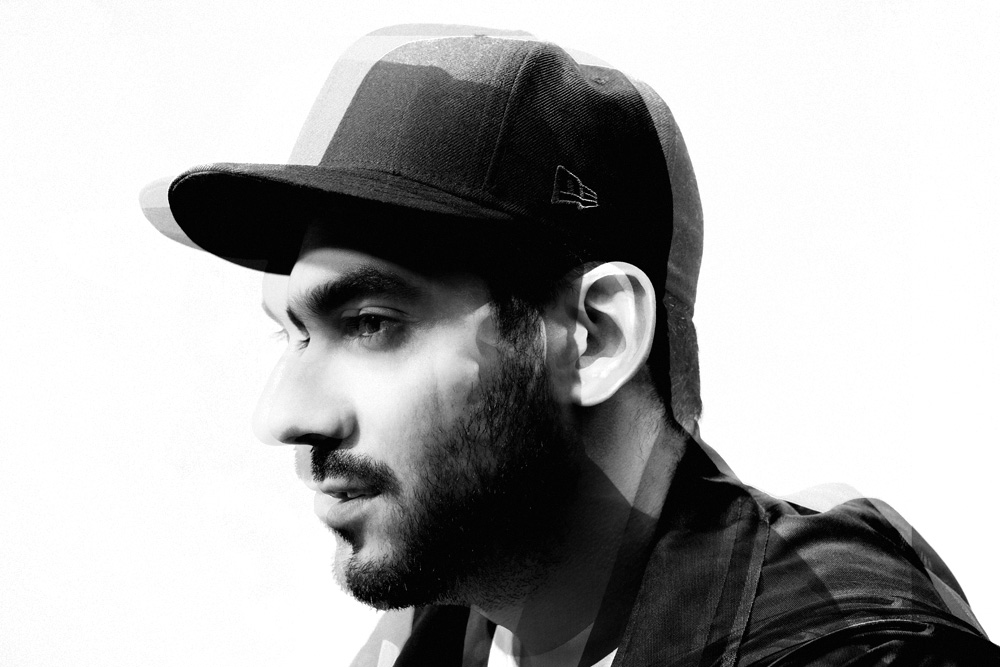採訪/INTERVIEW :SPITZ
撰文/CN :ESSY CHIU
PHOTO BASE : Maurice Choi, maurice.choi@gmail.com
PHOTO MANIPULATION : THETHINKTANKCRE8IVE
Aitor Throup不下數次強調他是產品設計師及藝術家而不是時裝設計師。雖然他的時裝作品打從他在2006年于London Royal College of Art畢業時便開始備受注目。但這位別具一格的設計師卻不願與今日時裝圈混為一談,出道7年以來只跟隨自己的意願而行,設立自己的一套準則,向自己的目標進發,名與利對他來說不比挑戰自我更為重要。比起很多同輩的名成利就的年輕設計師他看起來可能有點兩袖清風,但就是這種堅毅與不妥協,令這位阿根廷籍的年輕設計師看起來更有攝人的魅力以及更難能可貴。
Throup的設計充滿美感同時又有很多理性的計算在內。他曾經在一些訪問中說過希望不斷創新,但他同時深深明白一件物件只有具有來龍去脈才能引起共嗚,所以他亦不諱言會參考物件的出處,然後在設計的過程中,不斷拷問,研發一套自我的規則,再創造完全屬於自己的發明,像「Aitor sleeves」、「Aitor legs」等這些絕對讓你可以花上一些時間解讀的有趣時裝。儘管有點與時裝圈不相為謀,他說絕對尊重今日的時裝,只不過今日很多時裝設計師在這個已既定好的時裝業做著的,不是自己所想做的事情,他不想因為時裝業六個月為一個週期的規定而將自己喜歡的、辛辛苦苦做出的創作放棄,反而是希望將這些點子廷續下去,創作一些美麗但同時沒有破綻的物件。好一個充滿理想與堅持的設計師!
Fact. Aitor Throup claims himself to be more a product designer and artist, than a fashion designer. His designs have garnered him great attention from the very beginning. From his graduation collection for London Royal College of Art in 2006, his unique philosophies on design have set him apart from most of today’s fashion industry. He is one to set his own rules, moving with purpose towards individual, independant goals, and personal challenges. Fame clearly is not as important as the focus of vision. Compared with this generation’s young and successful contemporary designers, it is easy to overlook his achievements, and forget him in the mix. Yet his persistence, process and singularity is a powerful statement in itself and one that commands respect.
(English continued after Chinese)
SPITGAN – 你是否只設計男裝?
Aitor Throup – 是的,但開始的時候我沒有特別為自己鋪路去設計男裝,我不當自己是時裝設計師,反而會為自己定義為藝術家與產品設計師。因為時裝設計師對我來說,是有一個最終目標 (視野)的,那便是怎樣將一件衣服穿在人體身上而好看。但對我來說,那卻是一個巧合而已,穿得好看在我來說是加了分,但我的最終設計是一件沒有人體穿著的「靜止物件」,所以我展示的都是單一的產品設計。我不是特別想為男性設計成一種特定的打扮,我只不過選定了某一種形態。我的設計都是以產品設計為基礎,卻同時很容易與時裝融合。
SG – 那對你來說,設計男裝的挑戰在哪?設計時是否包含了很多心理因素在內?我問這個問題的原因是因為男裝都是很基本的,男性衣櫃來來去去的都是幾種衣物,形態都是差不多的,可能只有在物料上有一些不同,不像女裝,甚麼都有可能的。
A – 我不會說是一種挑戰。我在設計時對男性的心理特別感興趣,這亦是我的很多作品中所想探索的事物。我將男性對一些產品的興趣誇大,對他們為何會對一些物件發生興趣而不斷作出研究,希望瞭解他們這些欲望的來源與因由。我覺得這套思維來自我兒時對玩具的經驗,為何我會對一些玩具產生興趣一些卻不。很多男性兒時喜歡的玩具其實都有一些典故在內,這些角色人物是一個故事世界內的其中一部分。所以你買這些玩具的同時其實買的是整個故事。這種心理很適切於今日的男裝,亦很適切於我的創作。這些角色人物玩具通常都有一種特點,他們的設計通常存在一些功能,譬如說他們怎樣變身之類。一個figure公仔如果備有一些附加的配件,例如可脫下的頭盔等,你會感受到設計當中的真誠。這亦很像男性對男裝的態度,那種可以解構然後重組的欲望。基本上這就是我在做著的事情,怎樣解構後又重組一件衣服。我的每一件作品都有它的故事,都有它存在的理由,每一部分都有它的功能。
我覺得傳統男裝現存的問題是太過「規格化」,這是戰後產品開始工業化的後遺症,看最早期的軍服設計都是同一個規格的。而你看今日所謂最具創意的時裝圈,很多設計師都只是直接了當利用現有的標準去設計,例如袖孔就是一個很好的例子。當你讀時裝的時候,都是在這些現存的標準下設計,這些標準的袖孔在幾百年前已被設計出來,又在90多年前被規格化,而你卻在這些早已被視為標準的框架下讓創作備受規限?那根本不是我的創作,我不想沿用其他人的創作。我從來沒有在時裝業中汲取到什麼靈感,從來沒有想當一個時裝設計師。我常常可以看到這個時裝業有太多叫人質疑的問題。在我剛開始從事設計時,我已經可以透過設計來解決一些存在的問題,因為對我來說,設計亦即是要解決問題。
傳統的時裝設計師當開始設計一件衣物時,會先決定設計的是什麼,然後參考傳統的時裝例如T恤、恤衫外套等,而我卻可以從一件布料及人體來開始創作。我不是說我不會參考一般的衣物,如果這樣做的話我的作品便會太過抽象。那雖然是全新的發明但卻沒有上文下理與來龍去脈。我不覺得抽象藝術有太大的價值,那是自私的、完全屬於藝術家滿足自我的作品。那些來龍去脈的參考點讓你能與觀者聯繫起來,而我這些參考點又有一套意念去支持。像我穿著的這件軍用外套,便參考了swiss army jacket的一些細部。我放棄了傳統的縫紉方式而發明了一套全新系統去將袖孔縫上,我在傳統的縫紉機看到了對我來說是問題的所在點,然後找出解決問題的方法,我推翻了傳統的規格而創作出屬於自己的袖子,我就是喜歡在我自己的宇宙內發明新事物,繼而將之定為自己的規格,然後在這些自己定下來的框架下創作。
SG – 那你是否步向為自己拿專利的道路?聽起來你像是在發明一些全新的事物。
A – 這裏有太多東西是不能拿專利的,我只能盡力將自己的創作推到極致來保護作品。我很相信今日有很多偉大的藝術家,他們選擇了在自我定義的過程中來讓自己與別不同,來讓自己能創作出震撼人心的設計。你必需要對自己完全瞭解,你的訊息任何時候都必需要一致。你看今日很多設計師將自己的曾經創造過的訊息隨著6個月的時裝週期而將之拋棄,這從來不是我想做的事情。
SG – 你會說自己是街頭設計師嗎?
A – 絕對是的。我的根,我怎樣開始對時裝產生興趣,都是由街頭的造型而來。雖然我不會說我的作品與這些造型有什麼聯繫,它們卻由我對於一些造型的感情發展而來。我對足球十分著迷,當年我被身邊喜歡足球的人的打扮而薰陶,被他們在足球的次文化下對於忠於同一種打扮的態度所迷住。當年非常流行的品牌Stone Island、CP Company,它們在80、90年代帶領著一個朝代,這些足球迷對這兩個品牌的熱情,那是多麼的直接多麼充滿創意的表達方式,在當時可說是非常前衛的,我到今日仍感到非常著迷,在它們的設計中你可以找到很多創意。
我記得曾經有一件附有護目鏡的外套,像是一件花巧的時裝又像是superhero的衣服,但同時間它又絕對有功能性。我真的很喜歡他們將次文化的陰暗面與衣服中的前衛概念融合,是他們令我開始愛上時裝。他們的創作,例如「Urban Protection 」的一件附有防煙面具的外套,一個設有可接合踏板車的背包,還有一件設有防水的地圖可吹氣成浮沙發的衣物,一件可變成風箏的恤衫,那真的是概念男裝的頂點!
SG – 你的作品看起來與嘻哈文化、漫畫文化有著關連。
A – 是的,我很喜歡嘻哈文化,雖然我後期才對之產生興趣。我覺得它是今日一種最適切最有詩意的自我表達方式,當中有一些artist真的充滿才華。我對漫畫亦非常著迷。不是漫畫的觀點,亦不是特別喜歡追捧一個角色人物,而是當中那些引人入勝訊息。我從漫畫中更學到了怎樣繪畫很多關於人體的動作,看到漫畫家怎樣演繹人體的動力。
SG – 你有設計過運動鞋嗎?
A – 還沒有。
SG – 在進行中嗎?
A – 仍在我的腦海中。繼Umbro之後,我與Nike已開始合作了幾年。
SG – 我就是知道!但為什麼坊間沒有什麼消息。
A – 是的,還沒有任何聲音,是因為還沒有很明確。那是關於apparel innovation,對Nike來說可謂是新的事物,他們可能在鞋履上有很創新的點子,但在成衣方面創新仍是很新的事物。坊間對Nike的印象是一個很創新的品牌,我當然覺得他們很了不起,但他們一直以來都是在運動鞋履方面不斷革新。在全世界,成衣創新仍是很稀有的,直至最近才有Arteryx,一個來自加拿大的品牌。是他們發明防水拉煉的。
SG – 你覺得街頭時裝文化經常在創新嗎?
A – 是的,但街頭時裝的創新是true newness,是一些能真正表達自我的新事物,而在時裝的角度裏創新只是一些新的主題,有季節性的。我花很多時間來做我現在做著的事情,時裝界的人會說「你還在鑽研這個點子?!」不,我只是希望將這些點子變成新的、適切的事物。
SG – 你的畫作真的很了不起,你需要把它結集成書。
A – 會的。其實我們在不久將來會開始做成不同的印製品。4年半了,他們真的像是百科全書,所有的設計資料所有的project都在內。那真的很棒。
SG – 有那一位漫畫家對你影響深遠?
A – 有一位來自倫敦的藝術家Phil Hail。我有一陣子繪畫時腦海中經常出現他的作品。我們的畫作看起來很不同,但他的美學,他能在不同medium包括攝影、平面設計傳達訊息的能力,令他成為我最重要的靈感泉源。還有Chris Ware,他那些錯綜複雜的作品看起來是多麼的孤僻的。
(English Con’t)
SPITGAN – Are you strictly a menswear designer?
A -Yeah, but by default. I didn’t set out to design menswear, I guess that’s why I don’t consider myself a fashion designer. More somewhere between an artist and a product designer. I consider fashion designers, as designers with an end goal in mind. That being, of how the garments look on the human body, and how they are worn with outfits as well. Where for me, that’s completely co-incidental. Once that happens, that’s like a fun bonus thing at the end, for me the end point is a static object without the body inside of it. That’s why I present my work as singular, product objects. Its not that I’m focused on making men look a certain way, I’ve just chosen to do it in that shape. As it is so product based I am sure it could easily crossover, and be appropriated into men’s or womenswear which would be cool!
SG – What are the inherent challenges of designing for men, and is some of it psychological?
A – I don’t understand this thing as a challenge. I see it as what makes this thing interesting; the psychology of masculinity, which is in many ways what all of my work explores. Its actually an exaggeration of what I see is as a typically masculine approach to interacting with product. What attracts a man to approach a product. Its really just a reaction to, an ongoing analysis of that. Trying to understand what is it about certain things that attracts men to an object. I guess it starts as a kid with the kind of toys that interested me versus the one that didn’t interest me. I think there are 2 things, generally. With boy-liked toys, there is some contextual reference. Meaning there is a backstory to the toy, it is part of a bigger narrative. It is a toy of a character that belongs in a bigger world. So you’re buying into the whole depth of the story. That’s one thing that is very relevant to menswear, and very relevant to my work. Another thing is that there are functional parts. It does something, it transforms or…A figure would have a huge amount of added value if its has peripheral accessories, like a removable helmet or if it could fit into a vehicle, etc. you know what I mean? Basically what that is, is product integrity. You recognize that things have been considered. It’s a modern system of playing with modules, creating a bigger unified ‘thing’ made of multiple components. So its very rewarding for men to be able to take apart the components and put them back together. Basically that’s what I am doing, deconstructing and re-constructing a top. That’s a direct reflection on my work as well. Everything has to have a story, have a reason, and everything has to somehow do something!
SG – The reason I asked you that is because you look at what is menwear. Its pretty basic, you have the blazer, the sweater, etc. Granted there are materials that differ but the form is rather basic, unlike women where it can fly all over the place.
A – The way I see it, traditional menswear suffers from something called standardization. It’s really because of the war and the industrialization of products that came with it. Primarily military manufacturing, things had to become standardized. Even in the most creative corners of fashion, the vast majority of designers working today, are directly utilizing those standardized solutions. If we take for example, the armhole. There are two standardized types of armholes, which is the set in sleeve, like a suit jacket, or the other standardized sleeve, the raglan sleeve which is where you have a seam that runs all the way up the neck, and the sleeve runs over your shoulder, like a baseball top.
Even when you are learning about fashion, clothing, construction and techniques, your kind of given these 2 options. Some guy invented the set in sleeve 300 years ago, and another invented the raglan sleeve 150 years ago, and in turn they were industrialized 90 years ago. Now they have become standard and you are limiting my creativity by giving me 2 samples that some one else invented? Its not even my work, I don’t want to borrow their ideas. I think because I never had any aspirational value towards the fashion industry, I never wanted to become a fashion designer, I could always see very easily how the industry needed to be challenged. From the very beginning I’ve been able to design in a way to isolate the problem, because designing is like problem solving, thats what it is. I’ve been able to look at the problem without looking at others and they way they solve the problem. Traditionally a fashion designer, if you are designing a garment, would decide what kind of garment that would be. So you are already referencing a t-shirt, shirt, suit jacket, etc., an archetypal, standardized garment. I was able to start with human body and the fabric. That’s not to say that I don’t use references of generic garments. Of course, I do. If I didn’t my work would be abstract, then everything would be new and there would be no contextual point of reference. I don’t find abstract art so rewarding as a viewer. It’s selfish, its purely for the artist. Contextual points of reference allow you to connect with an audience. I use contextual points of reference but they have to have a conceptual validity. This jacket I’m wearing, for example, is a direct replica in the generic details of a Swiss Army jacket. In terms of the construction and methodology, the armhole, the machine that I used to stitch it together, I have invented a system where I am not using the standardized list of options. Like here are 2 stitch machine options, choose one. Every single person uses a machine like this to stitch this together. I analyzed what was wrong with those machines for me, what I didn’t like about them, and I figured out my own way of stitching things together. So I rejected the standard options and came up with the Aitor sleeve! I love the idea of inventing things and then standardizing them, within my own universe. Limiting myself because of it. So I standardize it and built equity into it, then it becomes part of the branding process as well.
SG – So are you moving towards patents in a way? It sounds like you are inventing things.
A – There a lot of things you can’t patent but it is a way of, lets say, protecting my work, as much as possible by defining it in an extemely purist way. I really believe all timeless artists that have made a difference and made an impact, have chosen to limit themselves through the acceptance of self definition and its paramount importance to everything. To say, you have to define yourself extremely well. Your message has to be consistent which goes against the majority of the fashion industry, where you see designers go away from a message six months after they have created it.
SG – Would you say you are a streetwear designer?
A – Totally. My roots, I got into clothing, strangely through style. My work, even though I say its not concerned with style; its curated with certain style sensibilities. I got into clothing from what I used to wear and everyone around me used to wear, to go watch football. Its kind of like that football casual sort of thing, football hooligans if you will. I used to be surrounded by that, and fascinated by that sense of uniformity in that subculture. In particular brands like Stone Island, CP Company, I still find it fascinating that it was such a defining era, the late 80’s and 90’s, that the football hooligans latched onto these brands, that were so avant garde at times. So directional, and expressive creatively. It went against the very nature of the culture, the overtly masculine and narrow-minded mentality of it all. There was a very real craving for expression found through these pieces. Like a jacket with goggles in it. Wow, it was like wearing a fancy dress or something, superhero outfits, but it just worked! I loved that juxtaposition, the darkness of that subculture and this incredible forward thinking garment. That’s how I fell in love with clothing. Then I fell in love with anything done by Massimo Osti (founder of CP and Stone Island). At the time Paul Harvey? was designing for stone Island and Moreno Ferrari? was designing for CP company. Maureno Ferrari did two incredible concepts. One was called, ‘Urban Protection’, and it had indestructable thread nylon jackets with smog masks built in. One had a scooter built into a backpack which you could fold out…just incredible! The other one he did was ‘Transformables’. With ‘Transformables’ he worked with a lot of heat sealing technology. You would have a waterproof map?, which would blow up and inflate into a blow up sofa! Or a shirt that would transform into a kite! Oh wow. That was conceptual menswear of the highest order.
SG – I come from North America and I see the connection of your work to Hip Hop culture, comics…
A – Yeah. I came to Hip Hop quite late actually. I am extremely passionate about Hip Hop. I think in current times it is the most relevant and poetic method of expression, and there are certain artists that are brilliant. Comics I was always fascinated by. Not from a story standpoint, or following the characters, but literally for the engrossing information. Every single panel just taught me more about different ways to draw the body from different angles. With comics I was studying different people’s interpretations of the human figure from all these dynamic different angles.
SG – It is amazing how you draw. You need to print some of those!
A – Oh yeah! We are starting next year actually. In january, we will start doing different series of prints. I am almost ready after about 4 and half years. Its encyclopedic, so all the information is there, every project is there and you’ll be able to buy prints from there. It will be cool.
SG – Any illustrators you would say particularly influenced you?
A – There is this artist called Phil Hale. He is an artist based in London, and basically, there was this moment in my studies where I came across his book randomly. Our drawings are not similar but his aethetic sensibility and his ability to convey that through multiple mediums, including graphic design and photography, he’s probably the single biggest influence on my work. I learned a lot, I studied that book. This guy is sick. He did a lot of comic book covers, the painted covers. I also like Chris Ware. Looks nothing like my work, but the intricacy of his work is almost autistic. Chris Ware has a book called, ‘The Smartest Kid on Earth’ and has a series called, ‘Acme Novelty Library’. Recently, in the last couple years he did a series called, ‘Lint’, oh my….Oh Taiyo Matsumoto as well. Japanese guy who did ‘TekkonKinKreet’, black and white artist.
SG – Have you ever done a sneaker?
A – Not yet.
SG – Is it in the works?
A – No no, it is in my head. I’ve been working Nike for the last couple of years post Umbro…
SG – Hahah I knew it! What have you done with them because its not apparent.
A – No no no. Its relatively silent because its not defined yet. The premise is apparel innovation, which strangely is new for Nike. They’ve never innovated with apparel just footwear.
SG – Oh I see, look at their whole image…
A – Right. Its the perception of the brand and you would think its about innovation. I think they are amazing, but their genuine product innovation has always been footwear. Apparel innovation is relatively rare globally. There’s only really in recent times, Arc’teryx, a Canadian company.
SG – They are into innovation?
A – They invented the waterproof zip.
SG – Everybody uses that now.
A – Yeah. They invented that. They just took a coil zipper from YKK, turned it around, laminated the back, figured how to run it all around and its waterproof! Then YKK started developing it for them, from them tinkering with it. They also invented the piece at the end of a zipper. The piece that’s almost like a ‘garage’, they invented that. They also have a sick lifestyle brand as well, ‘Arc’teryx Veilance’.
SG – Interesting. I think when I look at your work though I don’t associate it with these brands. You seem to bring cool design and innovation together. Whereas they are innovators but not as design progressive.
A – But they do it as well. I think what I do has the innovation but the art thing as well. Everything has a deep philisophical, political or moral weight as well, combined strangely with the streetwear thing. I think that’s quite unique to have an artistic and conceptual, product innovation streetwear label. I don’t think that has ever existed before. What Arc’teryx is trying to do with the Veilance line is that, without the artistic and conceptual part but innovation of the highest order.
SG – You think innovation is built into streetwear culture?
A – Yeah I think its either innovation or newness, but newness in streetwear is more like true newness. Where innovation in fashion is more thematic and seasonal. Newness in streetwear is like, ‘We want to see something new that redefines what we do and how we wear things’. That’s what I invest a lot of time in. In repeating and continuing things. Fashion looks at me like, ‘Oh you’re still working on that old idea’. No. I am trying to work an idea into something that becomes new and relevant. New in my language means, ‘that came in and everything was new, changed’.




Speak Your Mind